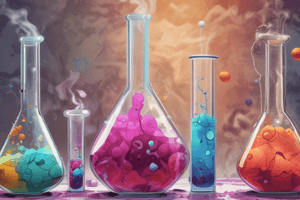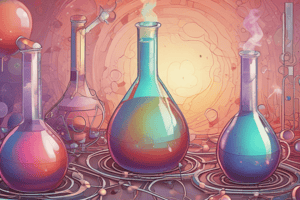Podcast
Questions and Answers
What are the four observations that can help determine if a chemical reaction has taken place?
What are the four observations that can help determine if a chemical reaction has taken place?
A change in state, a change in colour, the evolution of a gas, and a change in temperature.
What is the significance of studying chemical reactions and their symbolic representation?
What is the significance of studying chemical reactions and their symbolic representation?
To understand the various types of chemical reactions occurring around us.
What is the importance of observing changes around us in the context of chemical reactions?
What is the importance of observing changes around us in the context of chemical reactions?
It helps us identify the occurrence of chemical reactions.
What is the primary focus of this chapter?
What is the primary focus of this chapter?
Why is it essential to recognize the different types of chemical reactions?
Why is it essential to recognize the different types of chemical reactions?
What is the underlying phenomenon that occurs in daily life situations such as milk turning sour, iron rusting, grapes fermenting, food cooking, and food digestion?
What is the underlying phenomenon that occurs in daily life situations such as milk turning sour, iron rusting, grapes fermenting, food cooking, and food digestion?
What is the purpose of performing Activity 1.1, involving the burning of a magnesium ribbon?
What is the purpose of performing Activity 1.1, involving the burning of a magnesium ribbon?
How does the formation of hydrogen gas by the action of dilute sulphuric acid on zinc (Activity 1.2) illustrate a chemical reaction?
How does the formation of hydrogen gas by the action of dilute sulphuric acid on zinc (Activity 1.2) illustrate a chemical reaction?
What is the significance of observing changes in state, colour, evolution of gas, or temperature during a chemical reaction?
What is the significance of observing changes in state, colour, evolution of gas, or temperature during a chemical reaction?
What is the importance of recognizing the variety of chemical reactions that occur around us?
What is the importance of recognizing the variety of chemical reactions that occur around us?
What is the purpose of adding dilute hydrochloric acid or sulphuric acid to zinc granules in Activity 1.3?
What is the purpose of adding dilute hydrochloric acid or sulphuric acid to zinc granules in Activity 1.3?
What is the symbolic representation of the reaction between magnesium and oxygen, as described in Activity 1.1?
What is the symbolic representation of the reaction between magnesium and oxygen, as described in Activity 1.1?
What is the role of the arrow in a word-equation?
What is the role of the arrow in a word-equation?
What is the product formed when magnesium reacts with oxygen, as observed in Activity 1.1?
What is the product formed when magnesium reacts with oxygen, as observed in Activity 1.1?
What is the significance of the conical flask or test tube getting hotter in Activity 1.3?
What is the significance of the conical flask or test tube getting hotter in Activity 1.3?
Flashcards are hidden until you start studying
Study Notes
Identifying Chemical Reactions
- A chemical reaction can be identified by observing one or more of the following changes: • Change in state • Change in colour • Evolution of a gas • Change in temperature
Chemical Reactions in Our Environment
- A wide range of chemical reactions occur in our surroundings
- This Chapter will explore different types of chemical reactions and their symbolic representations
Chemical Reactions
- A chemical reaction occurs when the nature and identity of an initial substance change, resulting in a new substance with different properties.
- Examples of daily life situations that involve chemical reactions include:
- Milk left at room temperature during summers
- An iron tawa/pan/nail exposed to humid atmosphere
- Grapes getting fermented
- Food being cooked
- Food getting digested in our body
- Respiration
Identifying Chemical Reactions
- A chemical reaction can be identified by observing changes such as:
- Change in state
- Change in color
- Evolution of a gas
- Change in temperature
Chemical Equations
- A word-equation is a concise way to describe a chemical reaction in sentence form.
- The reactants (substances that undergo chemical change) are written on the left-hand side (LHS) with a plus sign (+) between them.
- The products (new substances formed during the reaction) are written on the right-hand side (RHS) with a plus sign (+) between them.
- An arrowhead points towards the products, showing the direction of the reaction.
- Example of a word-equation: Magnesium + Oxygen → Magnesium oxide
Studying That Suits You
Use AI to generate personalized quizzes and flashcards to suit your learning preferences.




